Australia , officially the Commonwealth of Australia, is

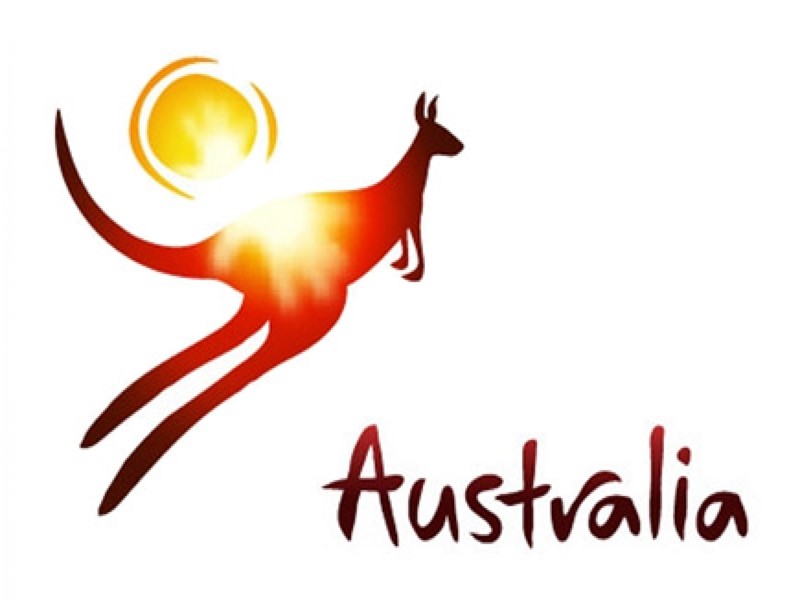
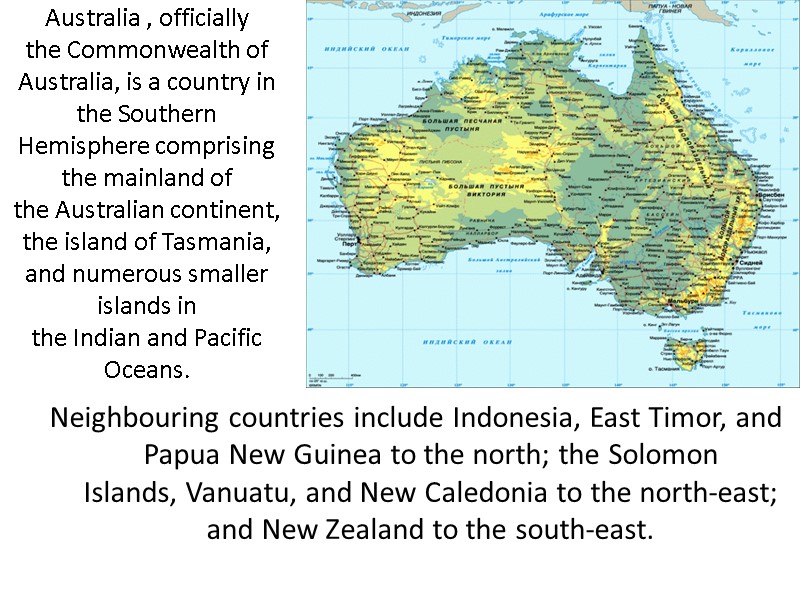
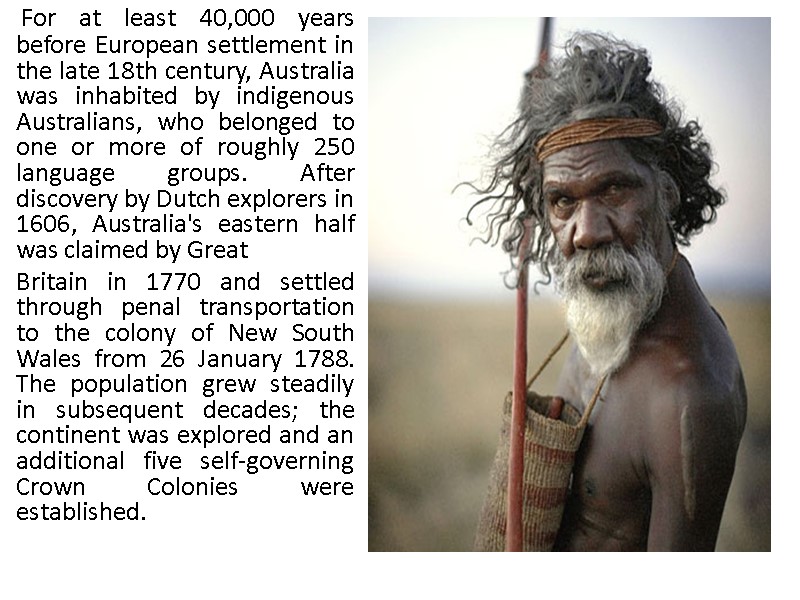
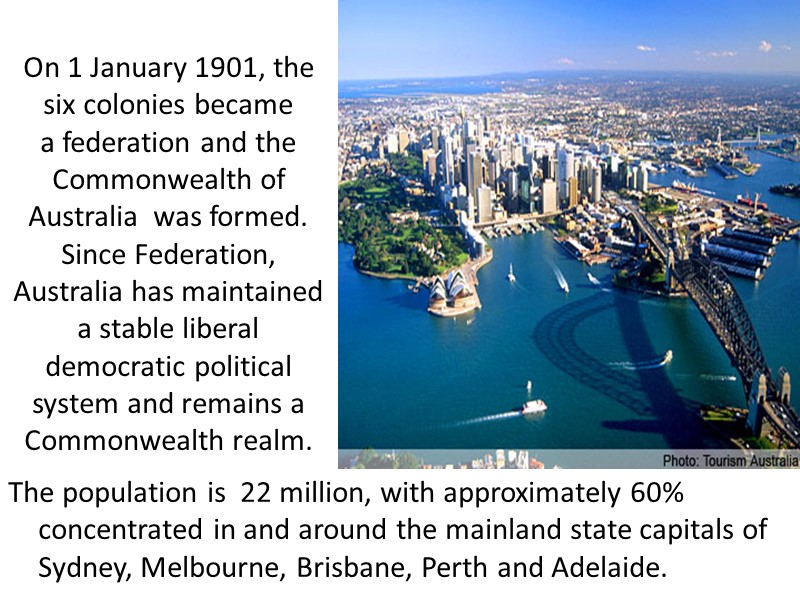
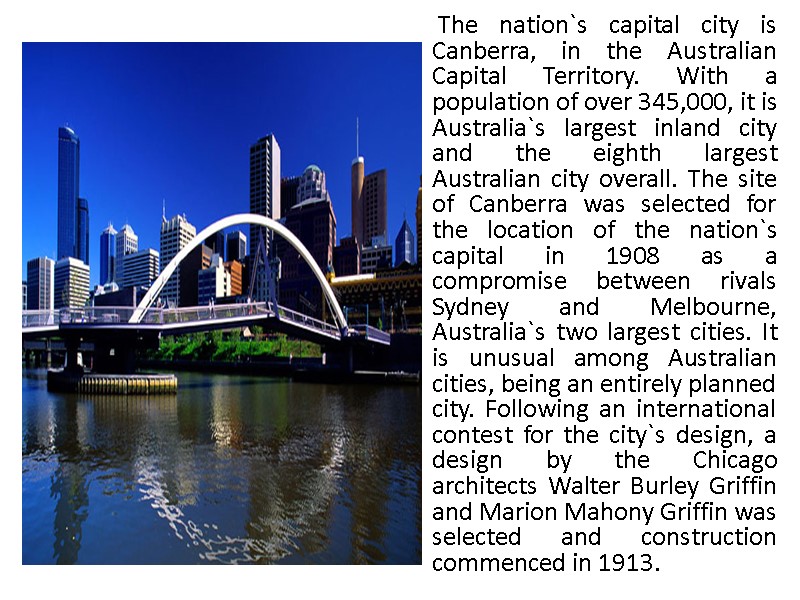
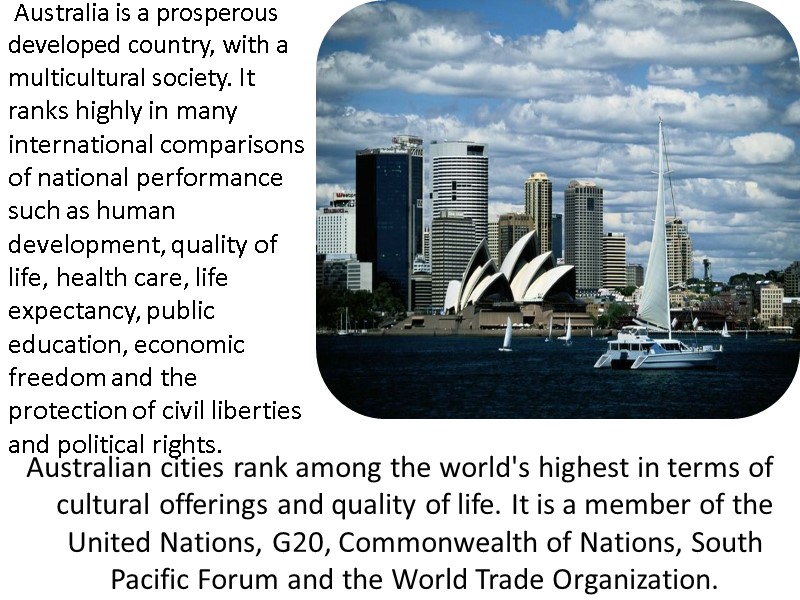
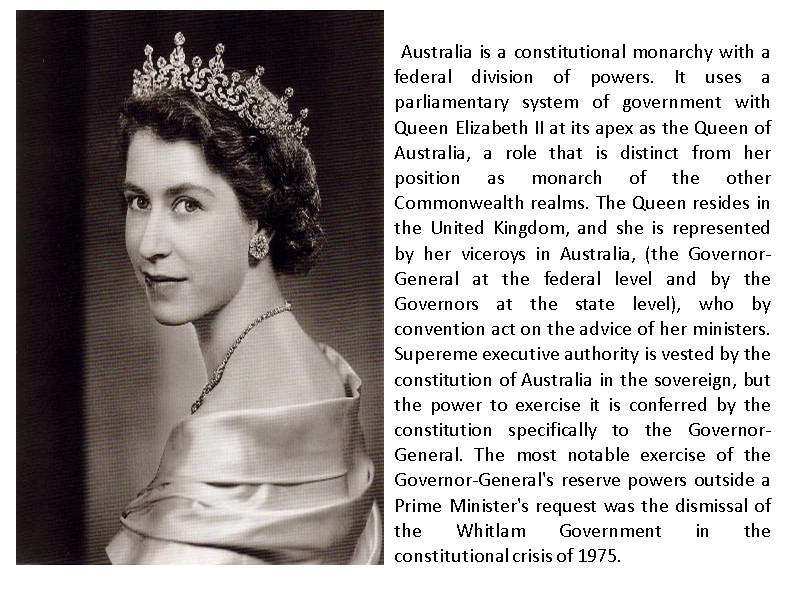
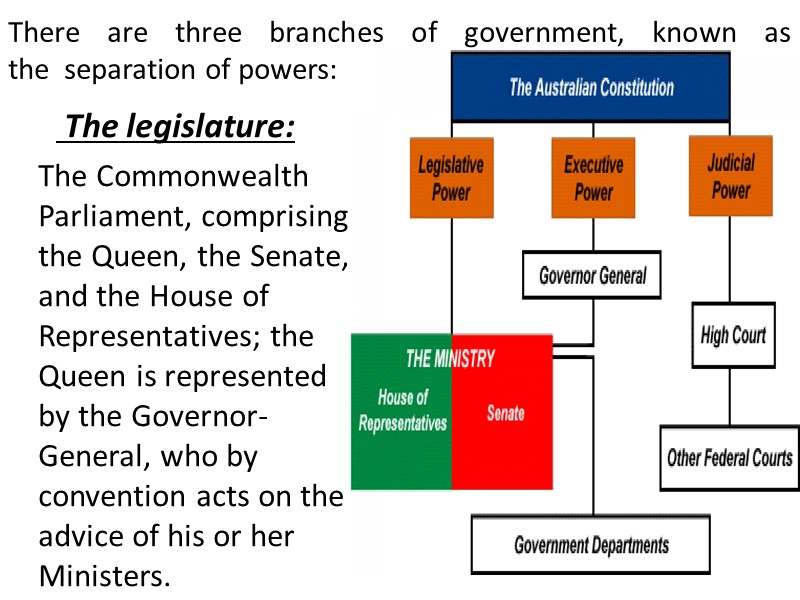
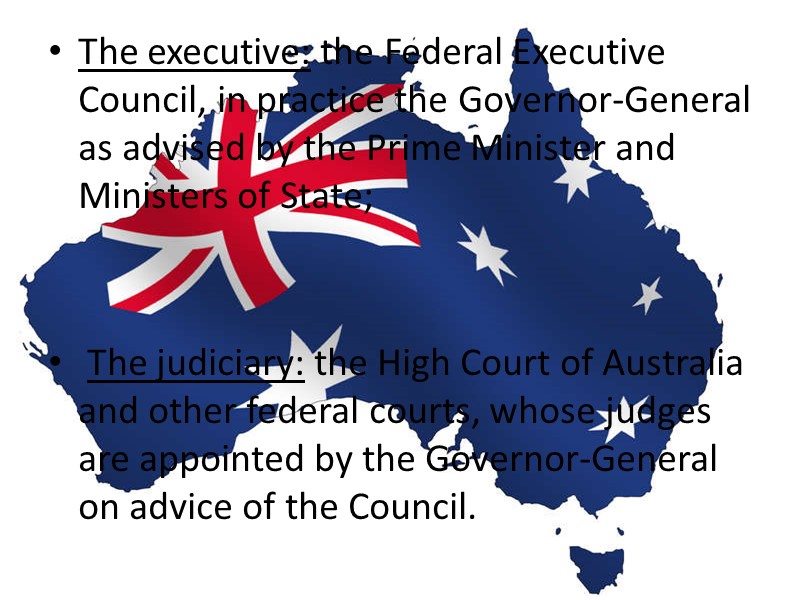
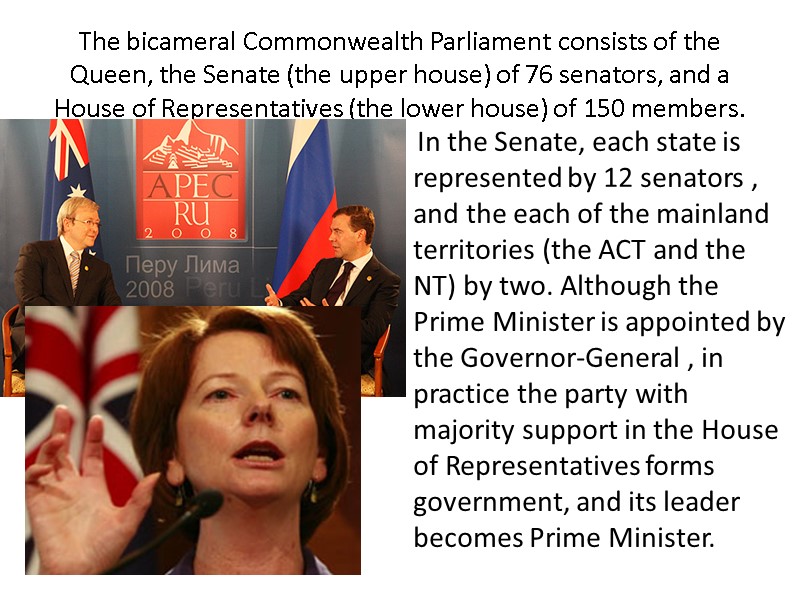
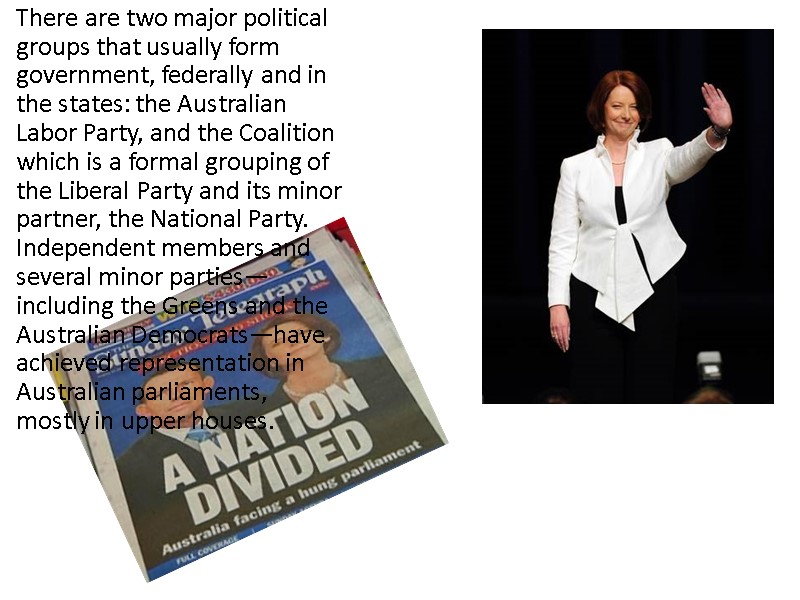
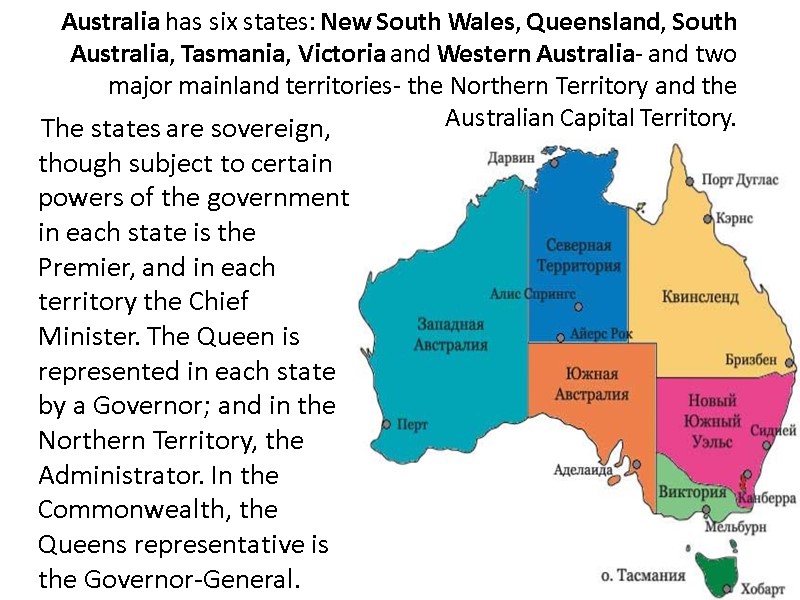
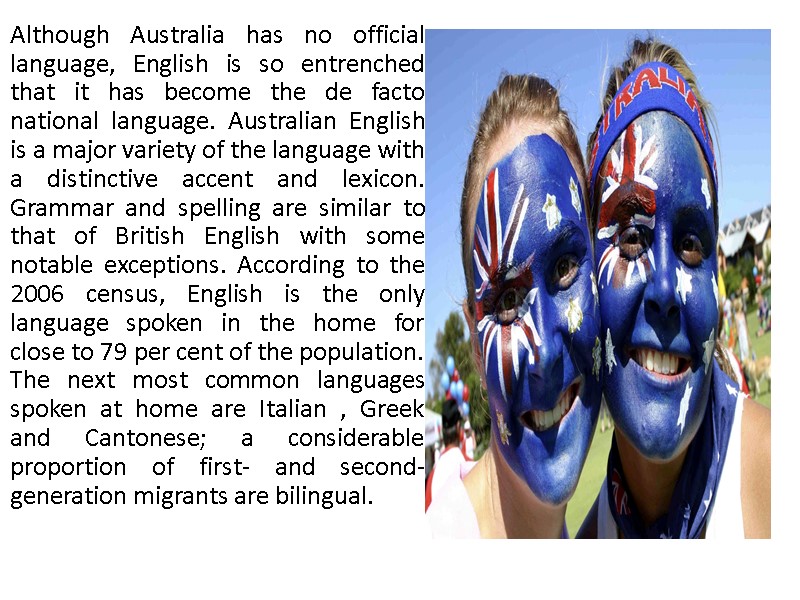
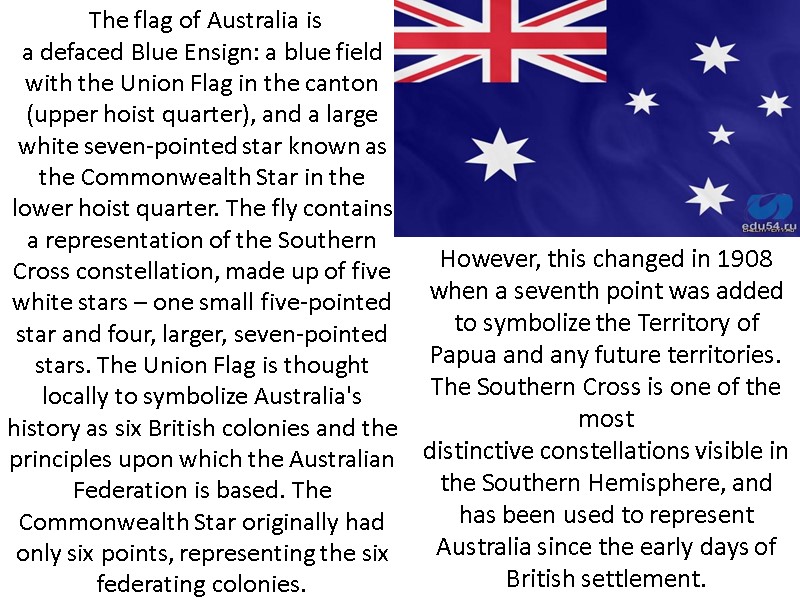
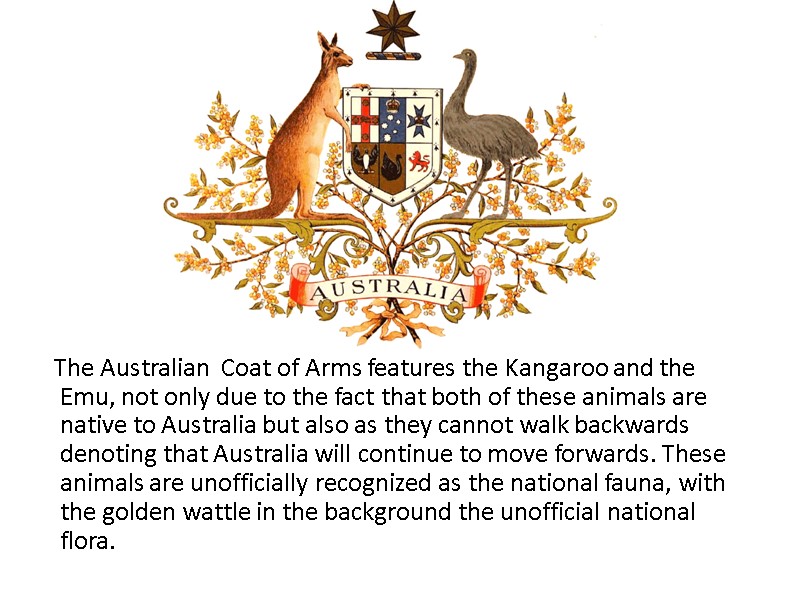
36564-australia.ppt
- Количество слайдов: 15

 Australia , officially the Commonwealth of Australia, is a country in the Southern Hemisphere comprising the mainland of the Australian continent, the island of Tasmania, and numerous smaller islands in the Indian and Pacific Oceans. Neighbouring countries include Indonesia, East Timor, and Papua New Guinea to the north; the Solomon Islands, Vanuatu, and New Caledonia to the north-east; and New Zealand to the south-east.
Australia , officially the Commonwealth of Australia, is a country in the Southern Hemisphere comprising the mainland of the Australian continent, the island of Tasmania, and numerous smaller islands in the Indian and Pacific Oceans. Neighbouring countries include Indonesia, East Timor, and Papua New Guinea to the north; the Solomon Islands, Vanuatu, and New Caledonia to the north-east; and New Zealand to the south-east.
 For at least 40,000 years before European settlement in the late 18th century, Australia was inhabited by indigenous Australians, who belonged to one or more of roughly 250 language groups. After discovery by Dutch explorers in 1606, Australia's eastern half was claimed by Great Britain in 1770 and settled through penal transportation to the colony of New South Wales from 26 January 1788. The population grew steadily in subsequent decades; the continent was explored and an additional five self-governing Crown Colonies were established.
For at least 40,000 years before European settlement in the late 18th century, Australia was inhabited by indigenous Australians, who belonged to one or more of roughly 250 language groups. After discovery by Dutch explorers in 1606, Australia's eastern half was claimed by Great Britain in 1770 and settled through penal transportation to the colony of New South Wales from 26 January 1788. The population grew steadily in subsequent decades; the continent was explored and an additional five self-governing Crown Colonies were established.
 On 1 January 1901, the six colonies became a federation and the Commonwealth of Australia was formed. Since Federation, Australia has maintained a stable liberal democratic political system and remains a Commonwealth realm. The population is 22 million, with approximately 60% concentrated in and around the mainland state capitals of Sydney, Melbourne, Brisbane, Perth and Adelaide.
On 1 January 1901, the six colonies became a federation and the Commonwealth of Australia was formed. Since Federation, Australia has maintained a stable liberal democratic political system and remains a Commonwealth realm. The population is 22 million, with approximately 60% concentrated in and around the mainland state capitals of Sydney, Melbourne, Brisbane, Perth and Adelaide.
 The nation`s capital city is Canberra, in the Australian Capital Territory. With a population of over 345,000, it is Australia`s largest inland city and the eighth largest Australian city overall. The site of Canberra was selected for the location of the nation`s capital in 1908 as a compromise between rivals Sydney and Melbourne, Australia`s two largest cities. It is unusual among Australian cities, being an entirely planned city. Following an international contest for the city`s design, a design by the Chicago architects Walter Burley Griffin and Marion Mahony Griffin was selected and construction commenced in 1913.
The nation`s capital city is Canberra, in the Australian Capital Territory. With a population of over 345,000, it is Australia`s largest inland city and the eighth largest Australian city overall. The site of Canberra was selected for the location of the nation`s capital in 1908 as a compromise between rivals Sydney and Melbourne, Australia`s two largest cities. It is unusual among Australian cities, being an entirely planned city. Following an international contest for the city`s design, a design by the Chicago architects Walter Burley Griffin and Marion Mahony Griffin was selected and construction commenced in 1913.
 Australia is a prosperous developed country, with a multicultural society. It ranks highly in many international comparisons of national performance such as human development, quality of life, health care, life expectancy, public education, economic freedom and the protection of civil liberties and political rights. Australian cities rank among the world's highest in terms of cultural offerings and quality of life. It is a member of the United Nations, G20, Commonwealth of Nations, South Pacific Forum and the World Trade Organization.
Australia is a prosperous developed country, with a multicultural society. It ranks highly in many international comparisons of national performance such as human development, quality of life, health care, life expectancy, public education, economic freedom and the protection of civil liberties and political rights. Australian cities rank among the world's highest in terms of cultural offerings and quality of life. It is a member of the United Nations, G20, Commonwealth of Nations, South Pacific Forum and the World Trade Organization.
 Australia is a constitutional monarchy with a federal division of powers. It uses a parliamentary system of government with Queen Elizabeth II at its apex as the Queen of Australia, a role that is distinct from her position as monarch of the other Commonwealth realms. The Queen resides in the United Kingdom, and she is represented by her viceroys in Australia, (the Governor-General at the federal level and by the Governors at the state level), who by convention act on the advice of her ministers. Supereme executive authority is vested by the constitution of Australia in the sovereign, but the power to exercise it is conferred by the constitution specifically to the Governor-General. The most notable exercise of the Governor-General's reserve powers outside a Prime Minister's request was the dismissal of the Whitlam Government in the constitutional crisis of 1975.
Australia is a constitutional monarchy with a federal division of powers. It uses a parliamentary system of government with Queen Elizabeth II at its apex as the Queen of Australia, a role that is distinct from her position as monarch of the other Commonwealth realms. The Queen resides in the United Kingdom, and she is represented by her viceroys in Australia, (the Governor-General at the federal level and by the Governors at the state level), who by convention act on the advice of her ministers. Supereme executive authority is vested by the constitution of Australia in the sovereign, but the power to exercise it is conferred by the constitution specifically to the Governor-General. The most notable exercise of the Governor-General's reserve powers outside a Prime Minister's request was the dismissal of the Whitlam Government in the constitutional crisis of 1975.
 There are three branches of government, known as the separation of powers: The legislature: The Commonwealth Parliament, comprising the Queen, the Senate, and the House of Representatives; the Queen is represented by the Governor-General, who by convention acts on the advice of his or her Ministers.
There are three branches of government, known as the separation of powers: The legislature: The Commonwealth Parliament, comprising the Queen, the Senate, and the House of Representatives; the Queen is represented by the Governor-General, who by convention acts on the advice of his or her Ministers.
 The executive: the Federal Executive Council, in practice the Governor-General as advised by the Prime Minister and Ministers of State; The judiciary: the High Court of Australia and other federal courts, whose judges are appointed by the Governor-General on advice of the Council.
The executive: the Federal Executive Council, in practice the Governor-General as advised by the Prime Minister and Ministers of State; The judiciary: the High Court of Australia and other federal courts, whose judges are appointed by the Governor-General on advice of the Council.
 The bicameral Commonwealth Parliament consists of the Queen, the Senate (the upper house) of 76 senators, and a House of Representatives (the lower house) of 150 members. In the Senate, each state is represented by 12 senators , and the each of the mainland territories (the ACT and the NT) by two. Although the Prime Minister is appointed by the Governor-General , in practice the party with majority support in the House of Representatives forms government, and its leader becomes Prime Minister.
The bicameral Commonwealth Parliament consists of the Queen, the Senate (the upper house) of 76 senators, and a House of Representatives (the lower house) of 150 members. In the Senate, each state is represented by 12 senators , and the each of the mainland territories (the ACT and the NT) by two. Although the Prime Minister is appointed by the Governor-General , in practice the party with majority support in the House of Representatives forms government, and its leader becomes Prime Minister.
 There are two major political groups that usually form government, federally and in the states: the Australian Labor Party, and the Coalition which is a formal grouping of the Liberal Party and its minor partner, the National Party. Independent members and several minor parties—including the Greens and the Australian Democrats—have achieved representation in Australian parliaments, mostly in upper houses.
There are two major political groups that usually form government, federally and in the states: the Australian Labor Party, and the Coalition which is a formal grouping of the Liberal Party and its minor partner, the National Party. Independent members and several minor parties—including the Greens and the Australian Democrats—have achieved representation in Australian parliaments, mostly in upper houses.
 Australia has six states: New South Wales, Queensland, South Australia, Tasmania, Victoria and Western Australia- and two major mainland territories- the Northern Territory and the Australian Capital Territory. The states are sovereign, though subject to certain powers of the government in each state is the Premier, and in each territory the Chief Minister. The Queen is represented in each state by a Governor; and in the Northern Territory, the Administrator. In the Commonwealth, the Queens representative is the Governor-General.
Australia has six states: New South Wales, Queensland, South Australia, Tasmania, Victoria and Western Australia- and two major mainland territories- the Northern Territory and the Australian Capital Territory. The states are sovereign, though subject to certain powers of the government in each state is the Premier, and in each territory the Chief Minister. The Queen is represented in each state by a Governor; and in the Northern Territory, the Administrator. In the Commonwealth, the Queens representative is the Governor-General.
 Although Australia has no official language, English is so entrenched that it has become the de facto national language. Australian English is a major variety of the language with a distinctive accent and lexicon. Grammar and spelling are similar to that of British English with some notable exceptions. According to the 2006 census, English is the only language spoken in the home for close to 79 per cent of the population. The next most common languages spoken at home are Italian , Greek and Cantonese; a considerable proportion of first- and second-generation migrants are bilingual.
Although Australia has no official language, English is so entrenched that it has become the de facto national language. Australian English is a major variety of the language with a distinctive accent and lexicon. Grammar and spelling are similar to that of British English with some notable exceptions. According to the 2006 census, English is the only language spoken in the home for close to 79 per cent of the population. The next most common languages spoken at home are Italian , Greek and Cantonese; a considerable proportion of first- and second-generation migrants are bilingual.
 The flag of Australia is a defaced Blue Ensign: a blue field with the Union Flag in the canton (upper hoist quarter), and a large white seven-pointed star known as the Commonwealth Star in the lower hoist quarter. The fly contains a representation of the Southern Cross constellation, made up of five white stars – one small five-pointed star and four, larger, seven-pointed stars. The Union Flag is thought locally to symbolize Australia's history as six British colonies and the principles upon which the Australian Federation is based. The Commonwealth Star originally had only six points, representing the six federating colonies. However, this changed in 1908 when a seventh point was added to symbolize the Territory of Papua and any future territories. The Southern Cross is one of the most distinctive constellations visible in the Southern Hemisphere, and has been used to represent Australia since the early days of British settlement.
The flag of Australia is a defaced Blue Ensign: a blue field with the Union Flag in the canton (upper hoist quarter), and a large white seven-pointed star known as the Commonwealth Star in the lower hoist quarter. The fly contains a representation of the Southern Cross constellation, made up of five white stars – one small five-pointed star and four, larger, seven-pointed stars. The Union Flag is thought locally to symbolize Australia's history as six British colonies and the principles upon which the Australian Federation is based. The Commonwealth Star originally had only six points, representing the six federating colonies. However, this changed in 1908 when a seventh point was added to symbolize the Territory of Papua and any future territories. The Southern Cross is one of the most distinctive constellations visible in the Southern Hemisphere, and has been used to represent Australia since the early days of British settlement.
 The Australian Coat of Arms features the Kangaroo and the Emu, not only due to the fact that both of these animals are native to Australia but also as they cannot walk backwards denoting that Australia will continue to move forwards. These animals are unofficially recognized as the national fauna, with the golden wattle in the background the unofficial national flora.
The Australian Coat of Arms features the Kangaroo and the Emu, not only due to the fact that both of these animals are native to Australia but also as they cannot walk backwards denoting that Australia will continue to move forwards. These animals are unofficially recognized as the national fauna, with the golden wattle in the background the unofficial national flora.

